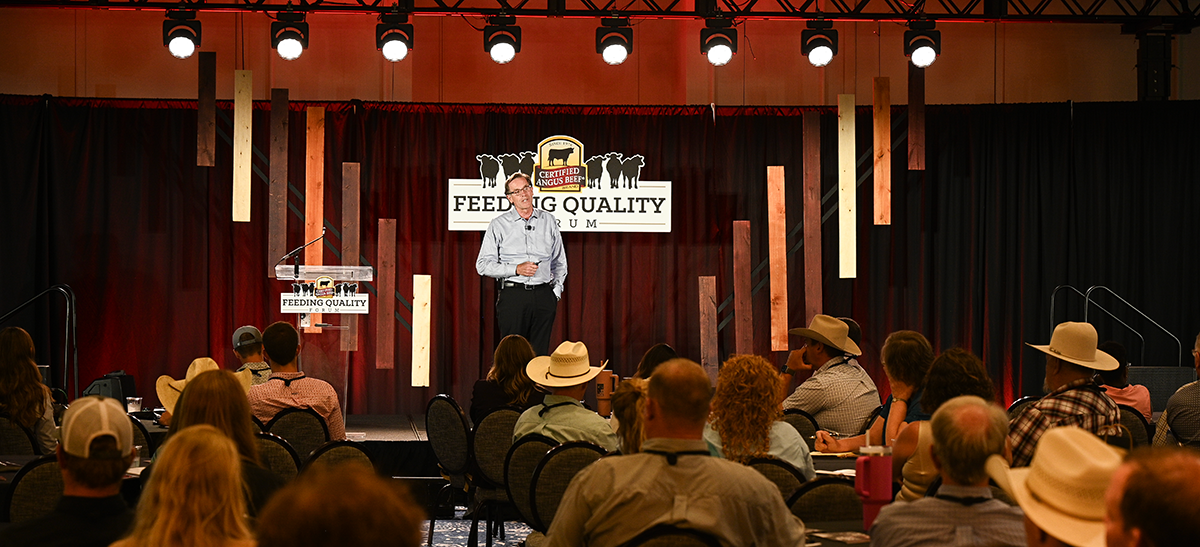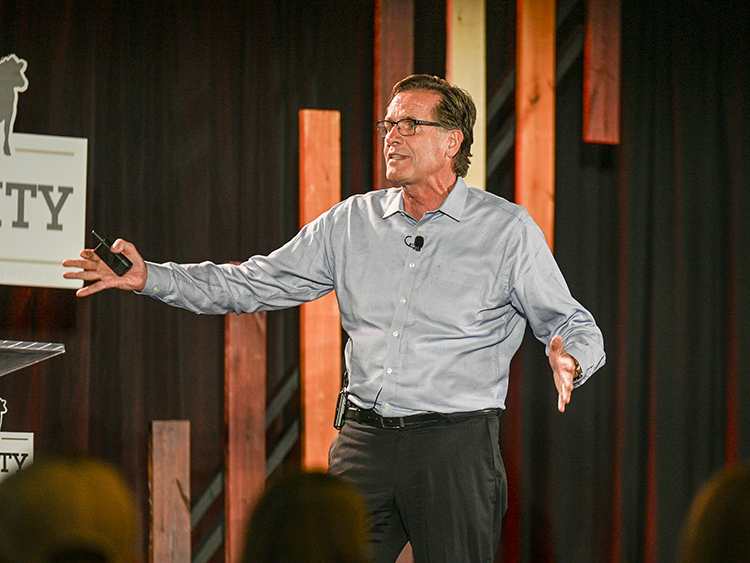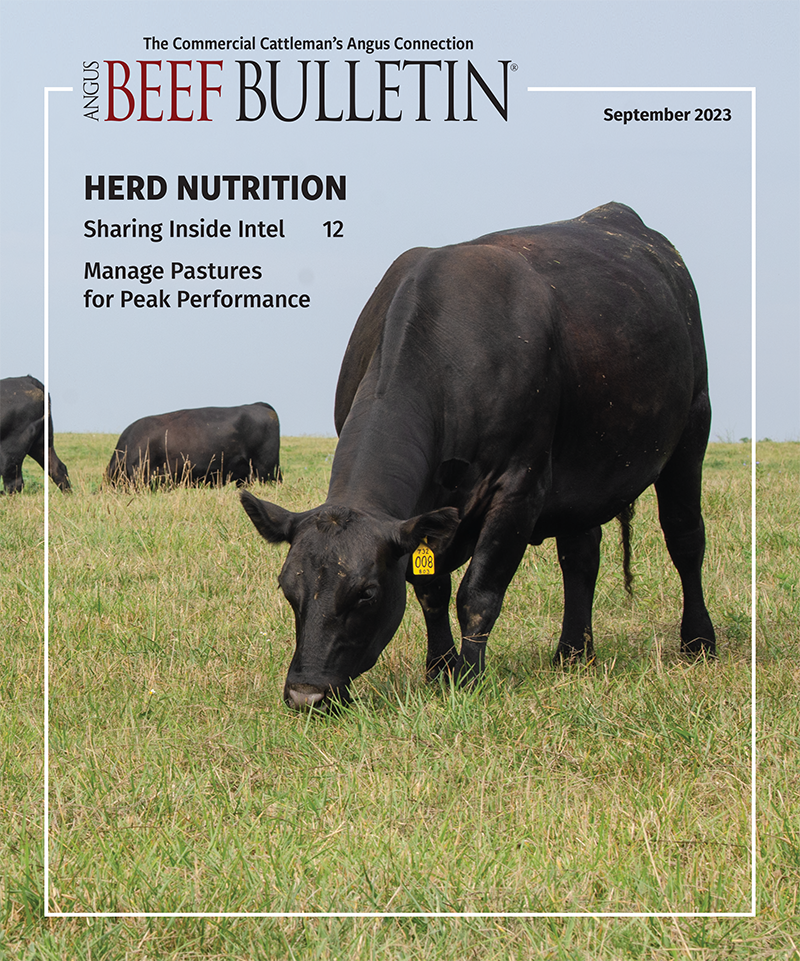
Long-term Ag Economy Strong, But Volatile
Basse tells Feeding Quality Forum attendees to expect a 60¢ swing in cattle price.
As a whole, U.S. farmers will make less money than they did last year — unless they have cattle. That’s according to Dan Basse, president, AgResource Co., who spoke at the 2023 Feeding Quality Forum in Lincoln, Neb., Aug. 22-23.
USDA projects farm income down 16%, or $151 billion, this year, with cattle and wheat the only two commodities increasing compared to the prior year.
When weighing expenses and income, feed prices will continue to take up a larger portion of the expense side of the cattleman’s balance sheet.
No more land, yields must increase
“I have faith in you farmers. Whether it’s every calf or every crop, you treat it like your firstborn. You give it its best chance,” Basse said, pointing out that from the 1970s through 2017 or 2018 that love and admiration really paid off.
Global crop yields rose year after year during that period; however, for the last six years they’ve stagnated. AgResource blames this on “heat-flation,” or the rising temperatures around the world.
Without an increase in yields, grain needs will demand more land in production.
“The world will need 23 to 25 million extra acres in the next five to seven years. Where’s that going to come from?” he asked. “It’s not coming from the United States, because we’re at what we call peak farmland.”
Unless the government releases Conservation Reserve Program (CRP) land, the United States has reached its max. The country is currently at its lowest level of productive farmland since 1909, Basse said, losing ground to everything from solar farms to urban sprawl.
For this year, the analyst predicts a national average corn yield of 172-175 bushels (bu.) per acre and a bottom in the corn market at $4.50-$4.75 per bu.
There’s growing competition for corn acres, with demand for soybeans to produce renewable biodiesel competing for that land base. Basse said the United States needs 4-5 million additional acres to keep up with growing crush capacity.
“I do not want to become bearish on corn on a longer-term basis, because the world today just does not have enough supply,” he said.
Herd expansion slow
The upward beef market momentum will continue, but not at the pace of the past year, Basse said.
“We still are bullish on cattle, though I think the road ahead is going to be very choppy. It’s not easy now. That easy money has been made,” he said. “It’s not a marching bull market anymore.”

“We still are bullish on cattle, though I think the road ahead is going to be very choppy. It’s not easy now. That easy money has been made,” said Dan Basse. “It’s not a marching bull market anymore.” [Photos by Miranda Reiman.] |
Heifer slaughter numbers suggest a slow build. One barrier is the need for more capital and the higher cost to service that debt, and another is the sheer cost of feeder cattle and cow-calf pairs.
“You’ve got to have friendly bankers. I hope you guys are sending birthday cards to each and every one of your bankers, because you need money, and you need a lot of it,” Basse said. “Whether or not the cattle industry is able to expand depends upon capital, because, boy, it takes a lot of capital in this industry today.”
High beef prices have slowed beef exports, and recently packers have reduced harvest numbers with reduced hours — all factors in the weekly markets.
“I think the volatility in cattle and feeders is going to be dramatic,” Basse said, suggesting a range in fed cattle from $160 per hundredweight (cwt.) to $220 for a springtime high.
Outside factors
The “great economic reset” is ongoing, Basse said, and that affects everything from consumer demand to investments in agriculture.
Since 1950, there have been 12 major interest rate hikes. Three have produced “soft landings,” and the rest have caused recessions, Basse explained. Today’s interest rate sits at 5.5%, and that has helped cool inflation.
“My bet, and the bet of AgResource, is all of the data points to a soft landing, and I think that’s been very evident,” he said.
U.S. debt will rise to $32 trillion by the end of the year, and more dollars in circulation triggers a devaluation of the dollar. Every time the U.S. dollar loses strength, it bolsters the commodity index as investors shift funds back into agriculture.
“Within the last couple of weeks, we are seeing money start to return. All my hedge fund business is now starting to look at the long side of stuff again, which is commodities and, principally, agriculture,” Basse said.
The ag economy is strong, and the cattle business is a good place to be, Basse said, but it isn’t without challenges ahead.
“There will be opportunity, but boy, the volatility is going to give heartburn to a lot of you sometime in the next few months and into 2024,” he predicted.
Editor’s note: Certified Angus Beef hosted the 18th annual Feeding Quality Forum Aug. 22-23 in Lincoln, Neb. The event was sponsored by AngusLinkSM, Feedlot Magazine, Select Sires, Performance Livestock Analytics, Diamond V, and Drovers. To learn more or view coverage, visit www.feedingqualityforum.com.



